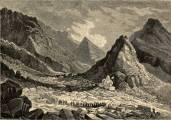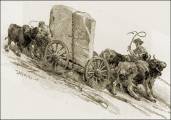


Indiana Limestone
Excerpts from A Guidebook to Mining In America:
Volume 2: East (Minnesota, Iowa, Missouri, Arkansas, Louisiana, and farther East) by John Park, Stonerose Publishing Co., Miami, Florida, April, 2000.
(The following is used with the permission of John Park.)
"Geologically, Indiana Limestone (aka Bedford limestone) is quarried from the Missisippian-age, oolitic, Salem (=Spergen) Limestone formation. Most quarrying occurs in the Bloomington-Bedford area. The Salem Limestone reaches a thickness of 80' but, where quarried, varies from 25' to 60'. The portion of the Salem Limestone that is quarried formed as underwater Sand dune fields.and partly as a result, is very pure-over 97% calcium carbonate. The limestone is soft when quarried and therefore is easily worked, but case-hardens on exposure. Because of the purity, it is unusually massive, and can be cut in blocks 5' wide by 13' high by 30' long or larger. This is unusual for limestone and is one of the reasons that Indiana limestone is especially valued. More practically, the limestone can hold fine detail and is unusually durable. Indiana limestone has been used in · the Empire State Building in NYC; · the Federal Triangle and Washington Cathedral in Washington, D. C., · the Alabama Museum of Natural History) (See AL-34[1] Geological Survey of Alabama Collection), and · the Indiana State Capitol building.
"Quarrying of Indiana Limestone began in 1827, about a mile south of Stinesville. By 1870, 15 quarries were in operation. Steam-powered channeling machines were put into service in 1875, and steam-powered gang-saws became common a few years later. Both enormously increased productivity. By 1900, Indiana limestone represented 1/3 of the total dimension limestone industry of the Nation, and this rose to 80% by 1920, but that's not to say that the industry was thriving-competition with concrete and steel-framed building techniques had greatly reduced the demand for dimension stone. Subsequently, the Depression, followed by WW II were hard times for the dimension stone industry. The industry continues to be important.
"Tours of a modern quarry can be taken at IN-10 Elliott Special Products. IN-5 McCormicks Creek State Park and IN-11 Spring Mill State Park contain former quarries. Museums that feature exhibits about limestone quarrying include the IN-6 Monroe County Historical Society Museum, the IN-8 Land of Limestone Exhibition, and the IN-9 Lawrence County Historical Museum.
"A Short History of Indiana Limestone, (available in libraries) is recommended. In Limestone Country by Scott Russell Sanders (not seen, available in libraries) is apparently mostly photographs of the quarry areas."
[1] These numbers refer to the book and section numbers in John Parks' books.
Commercial use of material within this site is strictly prohibited. It is not to be captured, reworked, and placed inside another web site ©. All rights reserved. Peggy B. and George (Pat) Perazzo.